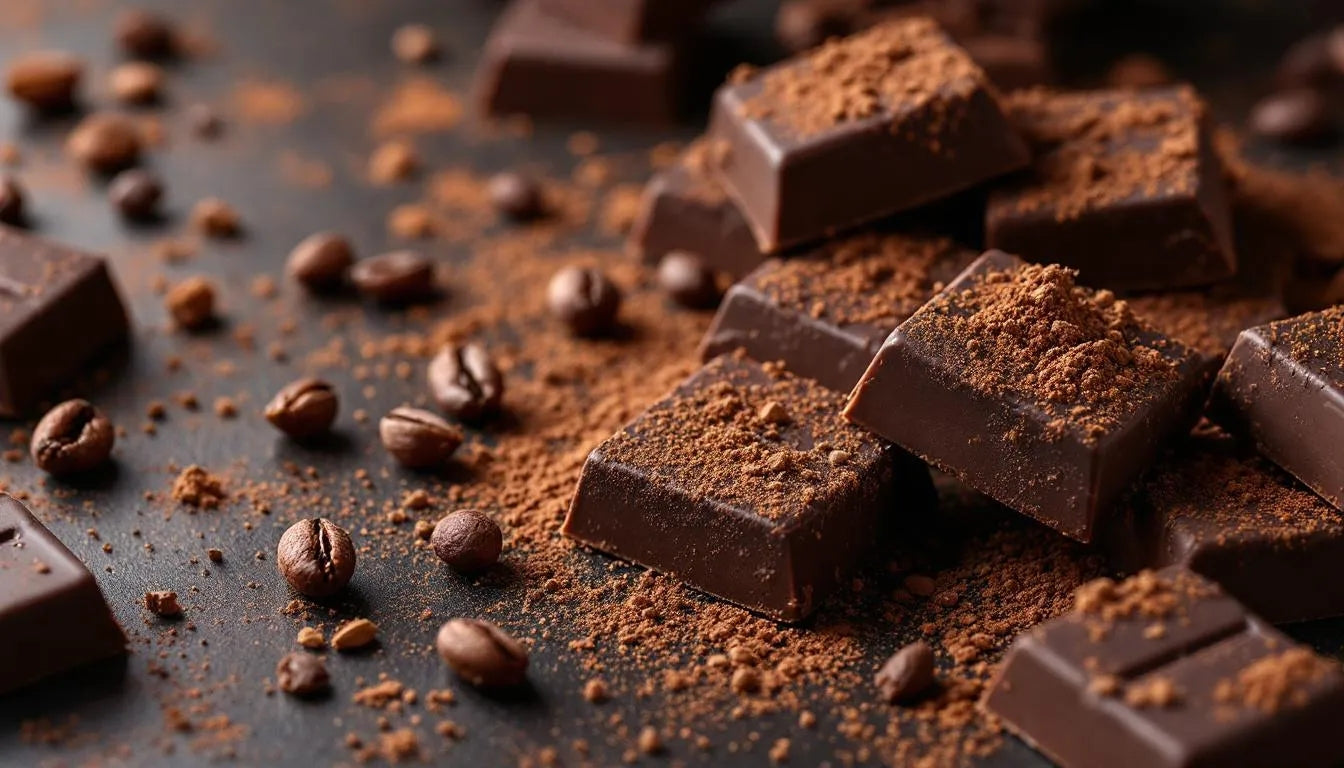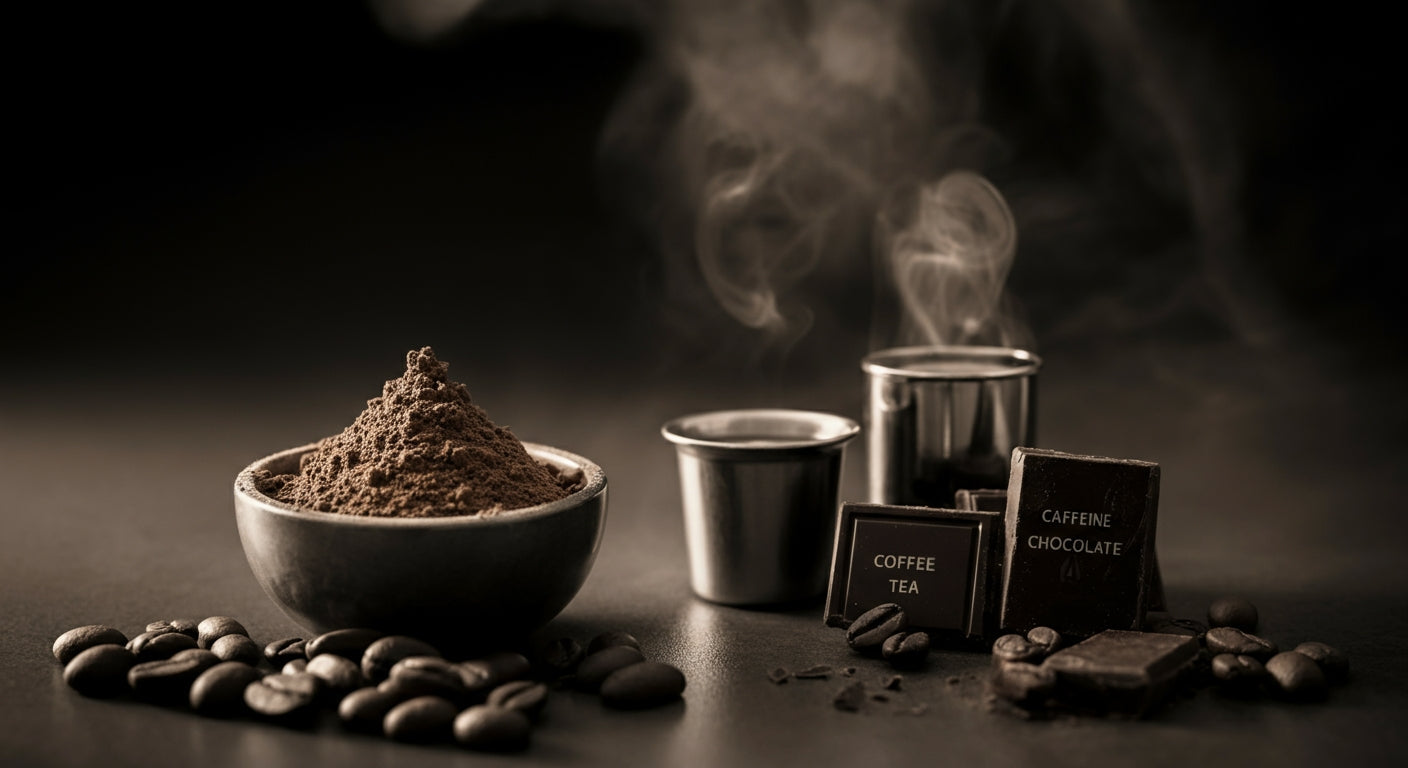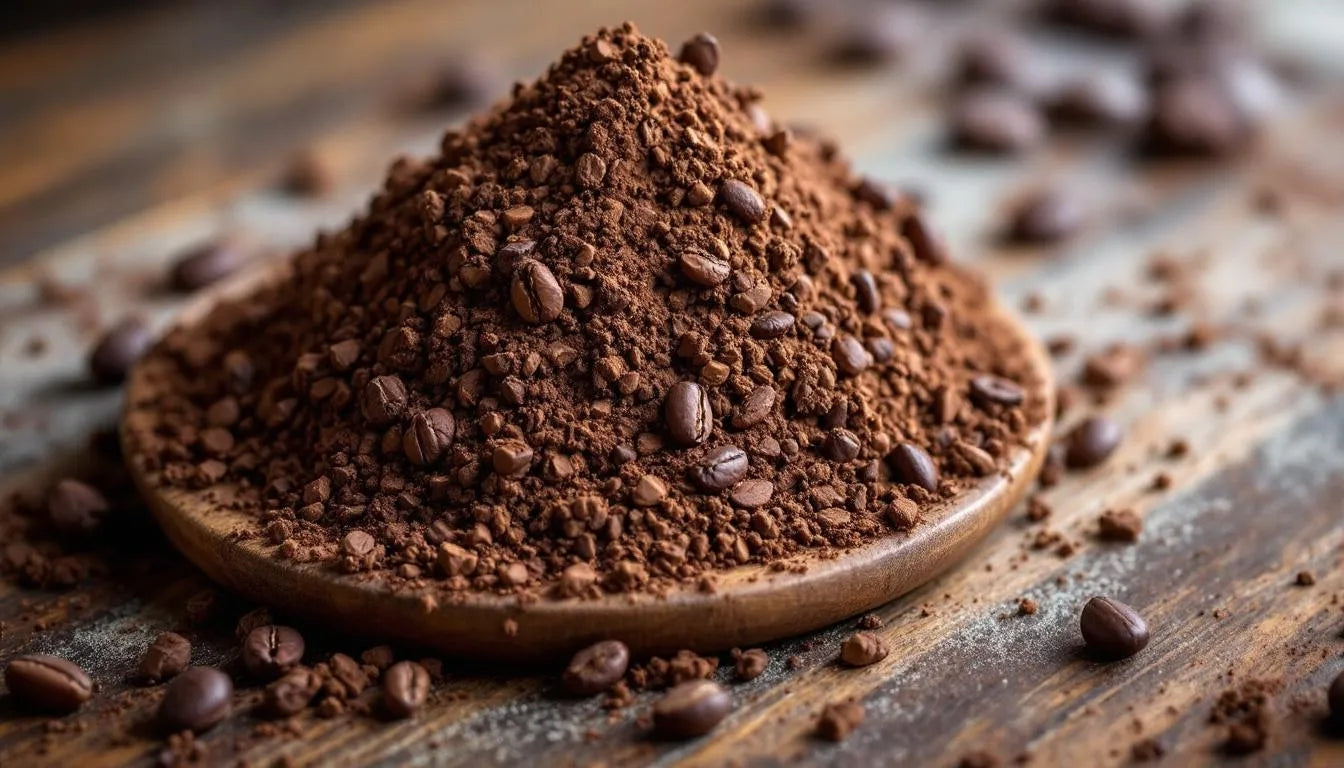
Does Dark Chocolate Have Dairy? Your Complete Guide to Dairy-Free Chocolate
If you're avoiding dairy for health, ethical, or dietary reasons, you might assume dark chocolate is automatically safe. The reality is that many dark chocolate products do contain dairy, even though pure dark chocolate doesn't inherently require milk ingredients. Understanding how to identify truly dairy-free dark chocolate is essential for those with lactose intolerance, milk allergies, or following vegan lifestyles. Let's explore everything you need to know about finding and enjoying dairy-free dark chocolate.
The Quick Answer: It Depends on the Brand
Pure dark chocolate should only contain cacao, sugar, and sometimes vanilla or lecithin. However, many commercial dark chocolate brands add dairy ingredients for texture, flavor, or due to shared processing equipment. Our organic chocolate bars are crafted to be naturally dairy-free, using only plant-based ingredients that deliver rich chocolate flavor without compromising dietary needs.
Why the Confusion Exists
Traditional Expectation: Many people assume "dark" means dairy-free Marketing Ambiguity: Brands don't always clearly highlight dairy content Processing Reality: Shared equipment can introduce cross-contamination Recipe Variations: Manufacturers may add milk for smoother texture

Common Dairy Ingredients in Dark Chocolate
Direct Dairy Additions
Milk Powder: Often added to reduce bitterness and create smoother texture Milk Fat: Used to enhance mouthfeel and creaminess Whey: Milk protein sometimes added for texture modification Lactose: Milk sugar occasionally used as a sweetener Butter: Some premium chocolates include butter for richness
Hidden Dairy Sources
Natural Flavors: May contain milk-derived compounds Lecithin: While soy lecithin is dairy-free, some lecithins come from milk Caramel Flavoring: Often contains milk proteins Cream: Listed in flavored dark chocolates
Cross-Contamination Indicators
"May contain milk" warnings: Indicates shared processing equipment "Processed in facilities that also process dairy": Cross-contamination risk Shared production lines: Even dedicated dairy-free recipes can be contaminated
Understanding our ingredient transparency helps you make informed choices about truly dairy-free chocolate options.
How to Read Labels for Dairy-Free Dark Chocolate
Ingredients to Avoid
Obvious Dairy Terms:
- Milk, milk powder, milk fat
- Cream, butter, buttermilk
- Whey, casein, lactose
- Any ingredient containing "lac" or "lact"
Less Obvious Sources:
- Natural flavors (may contain dairy)
- Caramel (often contains milk)
- Some vitamin D3 (can be derived from dairy)
Safe Ingredient Indicators
Pure Dark Chocolate Should Contain:
- Cacao or cocoa beans/liquor
- Cacao butter (naturally dairy-free)
- Sugar (various types)
- Vanilla extract or beans
- Lecithin (specify soy or sunflower)
Certification Labels to Look For
Vegan Certified: Guarantees no animal products Dairy-Free Certified: Specifically tests for dairy absence Plant-Based Labels: Indicates no animal-derived ingredients Kosher Pareve: Jewish dietary law classification for dairy-free products
Why Some Dark Chocolate Contains Dairy
Manufacturing Conveniences
Texture Enhancement: Milk powder creates smoother, less bitter chocolate Cost Reduction: Dairy fillers can be cheaper than pure cacao Consumer Preference: Many consumers prefer milder, creamier dark chocolate Production Efficiency: Shared equipment reduces manufacturing costs
Quality vs. Convenience Trade-offs
Mass Production: Large manufacturers often prioritize consistency over purity Flavor Masking: Dairy can mask lower-quality cacao flavors Shelf Stability: Some dairy ingredients extend product life Market Appeal: Creamier textures appeal to broader consumer base
Our commitment to purity means choosing quality over convenience, creating chocolates that are naturally dairy-free without compromising on flavor or texture.
Health Benefits of Dairy-Free Dark Chocolate
For Lactose-Intolerant Individuals
Digestive Comfort: No lactose means no digestive distress Full Enjoyment: Experience chocolate without health concerns Nutrient Absorption: Better mineral absorption without dairy interference Reduced Inflammation: Avoiding dairy may reduce inflammatory responses
For Milk Allergy Sufferers
Safety First: Eliminates risk of allergic reactions Peace of Mind: No worry about hidden dairy ingredients Social Inclusion: Can enjoy chocolate in social settings safely Nutritional Benefits: Access to chocolate's antioxidants without allergen exposure
For Vegan Lifestyle
Ethical Alignment: Supports plant-based values Environmental Benefits: Lower environmental impact than dairy chocolate Health Optimization: Cacao's natural benefits without animal products Inclusive Options: Suitable for various dietary restrictions
General Health Advantages
Antioxidant Power: Dark chocolate's flavonoids support cardiovascular health Mineral Content: Rich in magnesium, iron, and potassium Mood Enhancement: Natural compounds support emotional well-being Cognitive Support: May improve brain function and memory

Coracao's Naturally Dairy-Free Chocolate Collection
Our Pure Ingredient Philosophy
Our chocolate bars contain only:
- Organic, fair-trade cacao
- Natural sweeteners (coconut sugar)
- Pure cacao butter (naturally dairy-free)
- Vanilla beans
- Himalayan salt
No Hidden Ingredients: Complete transparency in every product No Cross-Contamination: Dedicated dairy-free processing No Compromise: Full flavor without dairy additions
Featured Dairy-Free Options
Berkeley Bar: Complex flavors with maca, lucuma, and almonds Hazelnut Chocolate Bars: Rich, nutty flavor without dairy Salted Caramel Chocolate: Sweet and salty balance using plant-based caramel Sugar-Free Options: Multiple varieties for various dietary needs
Quality Assurance
Single-Origin Sourcing: Direct from Peru's Huallaga Valley Organic Certification: Ensures pure, uncontaminated ingredients Fair-Trade Practices: Supports ethical cacao farming Rigorous Testing: Verification of dairy-free status
Alternative Ingredients That Replace Dairy
Natural Texture Enhancers
Cacao Butter: Provides creamy mouthfeel naturally Coconut Oil: Adds smoothness and tropical notes Nut Butters: Create richness in flavored chocolates Tahini: Sesame paste adds complexity and creaminess
Plant-Based Milk Alternatives
Coconut Milk: Rich, creamy texture for chocolate production Oat Milk: Provides smooth consistency Almond Milk: Light, nutty flavor enhancement Cashew Cream: Ultra-creamy texture for premium chocolates
Natural Flavor Enhancers
Vanilla Beans: Pure vanilla without dairy-derived compounds Sea Salt: Enhances chocolate flavor naturally Spices: Cinnamon, cardamom, and other spices add complexity Fruit: Natural fruit flavors complement chocolate
Our ingredient innovation demonstrates how plant-based alternatives can create superior chocolate experiences.
Shopping Guide: Finding Truly Dairy-Free Dark Chocolate
Questions to Ask Brands
- Do you use dedicated dairy-free equipment?
- What testing do you perform for dairy contamination?
- Are your natural flavors dairy-free?
- Do you have third-party dairy-free certification?
Warning Signs to Avoid
Vague Labeling: "Natural flavors" without specification May Contain Warnings: Indicates potential cross-contamination Unclear Sourcing: Multiple suppliers increase contamination risk Too-Good-To-Be-True Prices: Quality dairy-free chocolate costs appropriate amounts
Premium Quality Indicators
Single Ingredient Lists: Fewer ingredients mean less contamination risk Organic Certification: Often indicates cleaner processing Vegan Certification: Third-party verification of dairy-free status Transparent Sourcing: Clear origin and processing information

Making Dairy-Free Dark Chocolate at Home
Basic Recipe Using Cacao
Ingredients:
- 1/2 cup organic cacao powder
- 1/2 cup cacao butter, melted
- 1/4 cup coconut sugar or maple syrup
- 1 teaspoon vanilla extract
- Pinch of sea salt
Method:
- Melt cacao butter gently (keep below 118°F)
- Whisk in cacao powder until smooth
- Add sweetener, vanilla, and salt
- Pour into molds and refrigerate until set
Advanced Flavor Variations
Spiced Chocolate: Add cinnamon, cardamom, or chili Nutty Varieties: Incorporate almond or hazelnut butter Fruity Options: Add dried fruit or fruit powders Superfood Boost: Include ceremonial cacao for enhanced benefits
Learn more chocolate-making techniques through our comprehensive guides and recipes.
Health Considerations for Dairy-Free Diets
Ensuring Adequate Nutrition
Calcium Sources: Dark leafy greens, tahini, almonds Vitamin D: Sun exposure, fortified plant milks Protein Balance: Combine plant proteins throughout the day B12 Supplementation: Important for those avoiding all animal products
Dairy-Free Dark Chocolate Benefits
Easier Digestion: No lactose-related digestive issues Reduced Inflammation: May decrease inflammatory markers Better Mineral Absorption: Iron absorption not inhibited by calcium Pure Antioxidants: Maximum cacao benefits without interference
Cross-Contamination Prevention
At-Home Storage
Separate Storage: Keep dairy-free chocolate away from dairy products Clean Preparation: Use dedicated utensils and cutting boards Family Education: Ensure household members understand cross-contamination risks Clear Labeling: Mark dairy-free products clearly
When Dining Out
Ask Questions: Inquire about chocolate ingredients and preparation Bring Alternatives: Our portable chocolate options ensure safe treats Check Dessert Menus: Many restaurants now offer dairy-free options Communicate Clearly: Specify dairy allergy vs. dietary preference
The Future of Dairy-Free Dark Chocolate
Market Trends
Growing Demand: Increasing consumer awareness drives innovation Better Alternatives: Plant-based ingredients continue improving Mainstream Acceptance: Major brands developing dairy-free lines Premium Quality: High-end dairy-free options becoming standard
Innovation in Processing
Dedicated Facilities: More companies investing in dairy-free production Advanced Testing: Better detection methods for contamination New Ingredients: Novel plant-based alternatives emerging Sustainable Practices: Environmental benefits driving adoption
Our commitment to innovation keeps us at the forefront of dairy-free chocolate development.
Frequently Asked Questions
How can I tell if dark chocolate contains dairy without reading every ingredient?
Look for vegan certification symbols, "dairy-free" labels, or kosher "pareve" markings. Our chocolate bars are clearly labeled as vegan and dairy-free, making identification simple and reliable.
Is white chocolate coating on dark chocolate always dairy-containing?
Traditional white chocolate contains milk powder, but dairy-free alternatives exist using coconut milk or other plant-based ingredients. Always check labels, as our vegan chocolate options demonstrate that white coatings can be plant-based.
Can cross-contamination make dark chocolate unsafe for severe milk allergies?
Yes, even trace amounts from shared equipment can trigger allergic reactions. For severe allergies, choose chocolates made in dedicated dairy-free facilities with rigorous testing protocols, like our certified processes.
Why do some 85% dark chocolates still contain milk?
Higher cacao percentages don't guarantee dairy-free status. Manufacturers may add milk powder for texture or use shared equipment. Always check ingredient lists regardless of cacao percentage, and choose brands that specifically certify dairy-free status.
Are there nutritional differences between dairy-free and dairy-containing dark chocolate?
Dairy-free versions often provide better mineral absorption since calcium doesn't interfere with iron uptake. Cacao's natural benefits are more bioavailable without dairy interference, potentially offering superior health benefits.
How do I transition from dairy dark chocolate to dairy-free options?
Start with higher-quality dairy-free options that focus on pure cacao flavor rather than trying to replicate dairy creaminess. Our premium chocolate bars offer complex flavors that make the transition enjoyable rather than feeling like a compromise.
Quick Safety Guide (Featured Snippet Optimized)
Many dark chocolates contain dairy despite the name. Check ingredient lists for milk powder, whey, casein, or "may contain milk" warnings. Look for vegan certification, dairy-free labels, or kosher pareve markings. Pure dark chocolate should only contain cacao, sugar, and natural flavors. Cross-contamination from shared equipment is common.
Enjoy Dark Chocolate Confidently Without Dairy
Understanding that dark chocolate may contain dairy empowers you to make informed choices that align with your health needs and dietary values. Our collection of naturally dairy-free chocolate bars proves that eliminating dairy doesn't mean compromising on flavor, texture, or satisfaction.
From rich, complex Berkeley Bars to innovative sugar-free options, we demonstrate that pure, plant-based ingredients can create extraordinary chocolate experiences. Every bar is crafted with transparency, quality, and your dietary needs in mind.
Explore our complete dairy-free collection to discover how ethical sourcing, organic ingredients, and careful processing create chocolates that are not only safe for dairy-sensitive individuals but superior in taste and nutrition. From premium cacao powder for home chocolate-making to ceremonial cacao for wellness rituals, we support your journey toward conscious chocolate consumption.
Learn more about our ingredients and processes through our comprehensive blog, where we share transparency about our dairy-free commitment and provide guidance for enjoying chocolate safely regardless of your dietary restrictions.

Claire Bennett
I'm Claire, a chocolate lover and artisan based in a small town where I run a tiny home kitchen dedicated to exploring everything chocolate. From single-origin dark bars to creamy ganache and handmade truffles, I find joy in working with all types of chocolate. I believe chocolate has a story, and I love bringing that story to life through humble, heartfelt creations.



Leave a comment
This site is protected by hCaptcha and the hCaptcha Privacy Policy and Terms of Service apply.